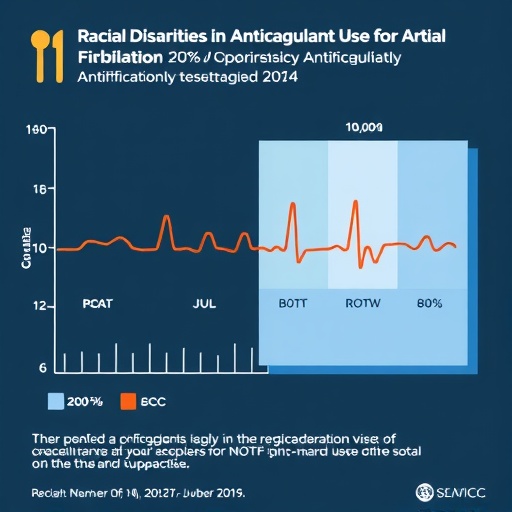In the realm of cardiovascular health, atrial fibrillation (AF) and atrial flutter (AFL) are conditions that have garnered attention due to their increasing prevalence and associated health risks. A breakthrough study published by Kan, Lapane, and McManus investigates the racial disparities and trends in anticoagulant use among ambulatory care patients diagnosed with AF and AFL from 2007 to 2019 in the United States. This research is particularly significant as it sheds light on how race and access to care impact treatment outcomes in this patient population.
Anticoagulant therapy is crucial in managing AF and AFL, primarily due to the heightened risk of stroke associated with these arrhythmias. Historically, the introduction of novel oral anticoagulants (NOACs) has transformed the treatment landscape, allowing for safer and more effective options compared to traditional anticoagulants like warfarin. However, access to these medications can be influenced by socio-economic factors and systemic health disparities, leading to a situation where not all populations benefit equally from these advancements.
Analyzing data from a vast sample of ambulatory care patients, the authors meticulously tracked prescription trends over the twelve-year period. They identified notable racial disparities in the initiation and adherence to anticoagulant treatment. For instance, minority populations—particularly Black and Hispanic patients—were less likely to receive anticoagulant therapy compared to their white counterparts. This finding is alarming, highlighting a potential inequity in the management of a condition that directly affects thousands of individuals across diverse backgrounds.
The authors underscore the factors contributing to these disparities, which include socioeconomic status, access to healthcare services, and variations in clinician recommendations based on patient demographics. These disparities not only affect individual health outcomes but may also lead to broader public health issues, worsening the overall burden of AF and AFL on the healthcare system. By concentrating on this pressing issue, the study underscores the need for targeted interventions that could help bridge the gaps in care.
Additionally, the study delves into the trends observed over the years. It appears that while overall anticoagulant usage has risen, the increase isn’t uniform across racial groups. The persistence of these disparities calls for a multifaceted approach to improve equity in treatment access. Strategies could include educational programs aimed at healthcare providers, policy changes that emphasize equitable distribution of resources, and community outreach initiatives to raise awareness regarding AF and AFL.
The rising recognition of these disparities is essential for enhancing the quality of care for all patients. The pharmaceutical and healthcare industries must strive for inclusivity in clinical trials, ensuring that drug efficacy and safety data are representative of the diverse population that these medications will ultimately serve. Only through a concerted effort can progress be made in eliminating these disparities that have plagued the healthcare system for too long.
Furthermore, the study highlights the critical role of healthcare providers in addressing these disparities. Differences in prescribing patterns may stem from implicit biases or a lack of awareness regarding the benefits of anticoagulation therapy in minority populations. To overcome these biases, healthcare professionals must engage in continuous education and training that emphasizes cultural competency. This approach will empower clinicians to make informed decisions that advocate for all patient populations.
Moreover, the authors stress the importance of patient education in improving adherence to anticoagulant therapy. Many individuals remain unaware of their risk factors associated with AF and AFL and the importance of anticoagulation treatment in preventing stroke. By providing accessible information and resources, healthcare providers can better engage patients in their treatment plans, leading to improved health outcomes and compliance.
As the authors discuss the implications of their findings, they call for further research on racial disparities in anticoagulant usage. Future studies should investigate specific barriers that minority populations face when accessing care. Understanding these barriers will inform strategies aimed at improving the management of AF and AFL, ultimately leading to better health outcomes for all patients.
The study’s implications extend beyond the individual patient. By acknowledging racial disparities in anticoagulant use, policymakers can develop initiatives that address systemic health inequities. Proactive measures that ensure equitable access to anticoagulants and other essential medications can foster healthier communities and reduce the burden of cardiovascular diseases globally.
As healthcare providers and researchers continue to unravel the complexities surrounding AF and AFL, collaborative efforts must be directed toward finding solutions. Building partnerships between hospitals, community organizations, and patient advocacy groups can amplify the voices of those affected and drive meaningful change in healthcare policies.
Ultimately, addressing these disparities will require a fundamental shift in the approach to healthcare delivery. Emphasizing equity, accessibility, and education can ensure that all patients, regardless of their background, receive the care they deserve. The findings from this study serve as a crucial step toward fostering a more equitable healthcare system, underscoring the importance of vigilance in monitoring and addressing ongoing disparities in anticoagulant use.
This research is a clarion call for stakeholders in the healthcare community to recommit to the fight against health inequities. By championing diversity in clinical practices, advocating for tailored patient education, and fostering an environment of inclusivity, the healthcare system can make strides toward equitable care for all individuals contending with atrial fibrillation and atrial flutter.
Subject of Research: Racial disparities and trends in anticoagulant use among ambulatory care patients with atrial fibrillation and atrial flutter.
Article Title: Racial disparities and trends in anticoagulant use among ambulatory care patients with atrial fibrillation and atrial flutter in the United States from 2007 to 2019.
Article References:
Kan, V., Lapane, K., McManus, D. et al. Racial disparities and trends in anticoagulant use among ambulatory care patients with atrial fibrillation and atrial flutter in the United States from 2007 to 2019.
BMC Health Serv Res 25, 1300 (2025). https://doi.org/10.1186/s12913-025-13397-y
Image Credits: AI Generated
DOI:
Keywords: Atrial fibrillation, Atrial flutter, Anticoagulant therapy, Racial disparities, Healthcare access, Health equity.




